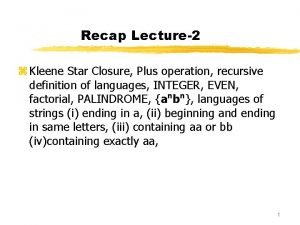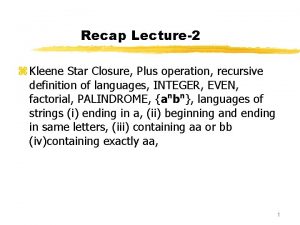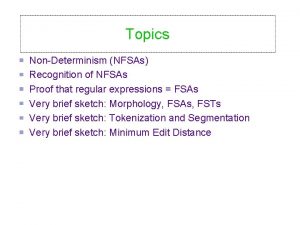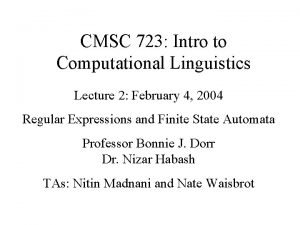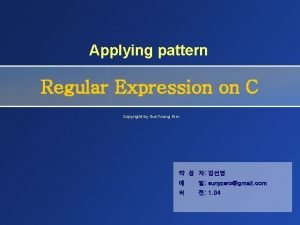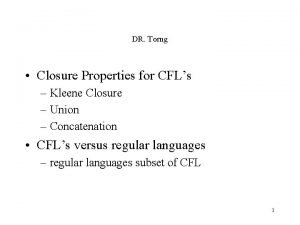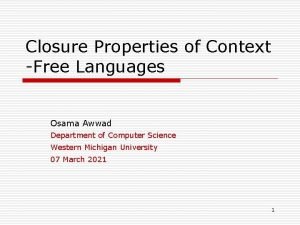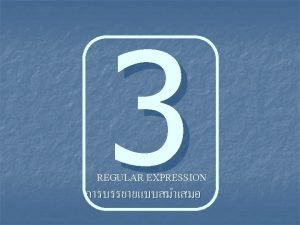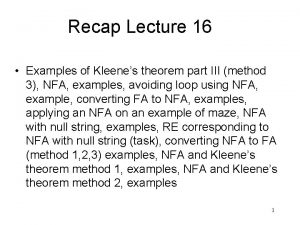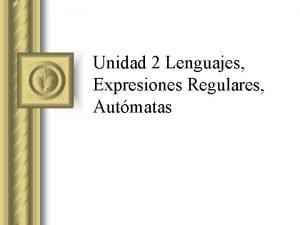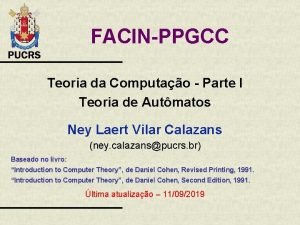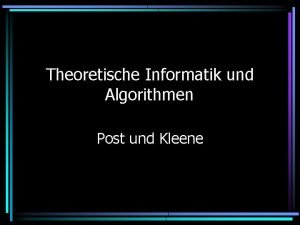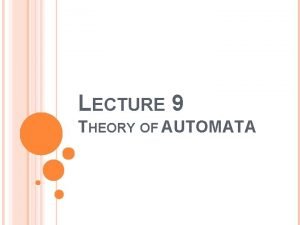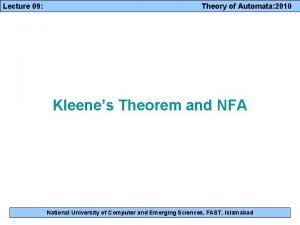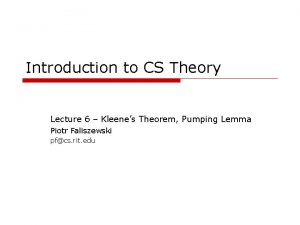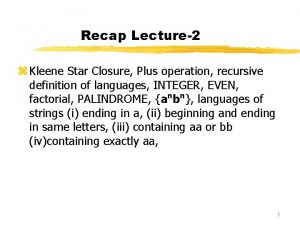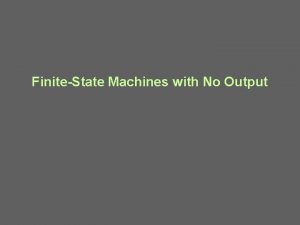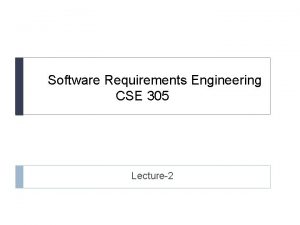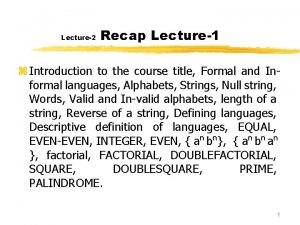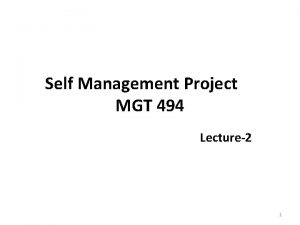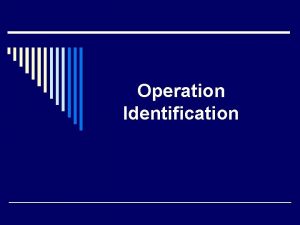Recap Lecture2 z Kleene Star Closure Plus operation
















- Slides: 16

Recap Lecture-2 z Kleene Star Closure, Plus operation, recursive definition of languages, INTEGER, EVEN, factorial, PALINDROME, {anbn}, languages of strings (i) ending in a, (ii) beginning and ending in same letters, (iii) containing aa or bb (iv)containing exactly aa, 1

Task z Q) 1) Let S={ab, bb} and T={ab, bbbb} Show that S* = T* [Hint S* T* and T* S*] 2) Let S={ab, bb} and T={ab, bbb} Show that S* ≠ T* But S* T* Solution: Since S T , so every string belonging to S* , also belongs to T* but bbb is a string belongs to T* but does not belong to S*. 2

Task Q 1)Is there any case when S+ contains Λ? If yes then justify your answer. Solution: consider S={Λ, a} then S+ ={Λ, a, aaa, …} Here Λ is in S+ as member of S. Thus Λ will be in S+ , in this case. 3

Q 2) Prove that for any set of strings S i. (S+)*=(S*)* Solution: In general Λ is not in S+ , while Λ does belong to S*. Obviously Λ will now be in (S+)*, while (S*)* and S* generate the same set of strings. Hence (S+)*=(S*)*. 4

Q 2) continued… ii) (S+)+=S+ Solution: since S+ generates all possible strings that can be obtained by concatenating the strings of S, so (S+)+ generates all possible strings that can be obtained by concatenating the strings of S+ , will not generate any new string. Hence (S+)+=S+ 5

Q 2) continued… iii) Is (S*)+=(S+)* Solution: since Λ belongs to S* , so Λ will belong to (S*)+ as member of S*. Moreover Λ may not belong to S+, in general, while Λ will automatically belong to (S+)*. Hence (S*)+=(S+)* 6

Regular Expression z As discussed earlier that a* generates Λ, a, aaa, … and a+ generates a, aaa, aaaa, …, so the language L 1 = {Λ, a, aaa, …} and L 2 = {a, aaa, aaaa, …} can simply be expressed by a* and a+, respectively. a* and a+ are called the regular expressions (RE) for L 1 and L 2 respectively. Note: a+, aa* and a*a generate L 2. 7

Defining Languages (continued)… z Method 3 (Regular Expressions) y. Consider the language L={Λ, x, xxx, …} of strings, defined over Σ = {x}. We can write this language as the Kleene star closure of alphabet Σ or L=Σ*={x}* this language can also be expressed by the regular expression x*. y. Similarly the language L={x, xxx, …}, defined over Σ = {x}, can be expressed by the regular expression x+. 8

y. Now consider another language L, consisting of all possible strings, defined over Σ = {a, b}. This language can also be expressed by the regular expression (a + b)*. y Now consider another language L, of strings having exactly double a, defined over Σ = {a, b}, then it’s regular expression may be b*aab* 9

y. Now consider another language L, of even length, defined over Σ = {a, b}, then it’s regular expression may be ((a+b))* y. Now consider another language L, of odd length, defined over Σ = {a, b}, then it’s regular expression may be (a+b)(a+b))* or ((a+b))*(a+b) 10

Remark z It may be noted that a language may be expressed by more than one regular expressions, while given a regular expression there exist a unique language generated by that regular expression. 11

z. Example: y. Consider the language, defined over Σ={a , b} of words having at least one a, may be expressed by a regular expression (a+b)*a(a+b)*. y Consider the language, defined over Σ = {a, b} of words having at least one a and one b, may be expressed by a regular expression (a+b)*a(a+b)*b(a+b)*+ (a+b)*b(a+b)*a(a+b)*. 12

y. Consider the language, defined over Σ={a, b}, of words starting with double a and ending in double b then its regular expression may be aa(a+b)*bb y. Consider the language, defined over Σ={a, b} of words starting with a and ending in b OR starting with b and ending in a, then its regular expression may be a(a+b)*b+b(a+b)*a 13

TASK y. Consider the language, defined over Σ={a, b} of words beginning with a, then its regular expression may be ? y. Consider the language, defined over Σ={a, b} of words beginning and ending in same letter, then its regular expression may be ? 14

TASK y. Consider the language, defined over Σ={a, b} of words ending in b, then its regular expression may be ? y. Consider the language, defined over Σ={a, b} of words not ending in a, then its regular expression may be ? 15

Summing. UP Lecture 3 RE, Recursive definition of RE, defining languages by RE, { x}*, { x}+, {a+b}*, Language of strings having exactly one aa, Language of strings of even length, Language of strings of odd length, RE defines unique language (as Remark), Language of strings having at least one a, Language of strings havgin at least one a and one b, Language of strings starting with aa and ending in bb, Language of strings starting with and ending in different letters. 16
 Kleene star operation
Kleene star operation Kleene star of a language
Kleene star of a language Kleene closure
Kleene closure Kleene closure
Kleene closure Kleene star example
Kleene star example Kleene star
Kleene star Closure property of context free grammar
Closure property of context free grammar Worgle
Worgle Star of wonder star of night star of royal beauty bright
Star of wonder star of night star of royal beauty bright Kleene's theorem example
Kleene's theorem example Cerradura positiva ejemplos
Cerradura positiva ejemplos Teorema de kleene
Teorema de kleene Daniel garmann
Daniel garmann Concatenation of two finite automata examples
Concatenation of two finite automata examples Kleene theorem
Kleene theorem Kleene's theorem part 3
Kleene's theorem part 3 Kleene's theorem
Kleene's theorem
